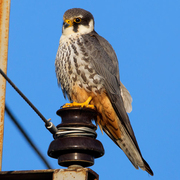Eurasian Hobby
Falco
subbuteo
Falconiformes
The hawks, eagles, falcons, and allies make up a group known as the diurnal raptors, because they are active during the day. Members of this group typically use their acute vision to catch live vertebrate prey with their strong feet and toes. They vary from medium-sized to large birds and most have an upright posture and strong, short, hooked bills. The New World vultures (not closely related to the Old World vultures) were once classified with the herons and allies, but they have provisionally been grouped with the diurnal raptors on the basis of recent genetic studies. Members of the order Falconiformes in Washington fall into three families:
Falconidae
This widespread and diverse family of predatory birds is divided into two groups. Some of the fastest-flying birds can be found in the falcon group. Built for speed, most falcons have pointed wings and long tails. Many catch avian prey in flight, but others prey on large insects, mammals, and ground-dwelling birds. Members of the caracara group are more opportunistic, taking carrion as well as live prey and often foraging on the ground. Regardless of the approach, members of this family almost always use their feet to catch prey. Like other birds of prey, females are larger than males. They are generally monogamous and form long-term pair bonds. Some caracaras build stick nests in trees, but most species in this family nest on cliffs, in other birds' nests, or in cavities, and typically do not add any nesting material. The female generally incubates the eggs and broods the young, while the male brings food to the nest. Once the young no longer need to be brooded, both parents bring food. Extended parental care is the norm for this family, as it takes a relatively long time for the young to learn to hunt. In Washington, one species from this family belongs to the caracara group, while the others are true falcons.
General Description
One record, from Discovery Park, Seattle (King County), in October 2001.









